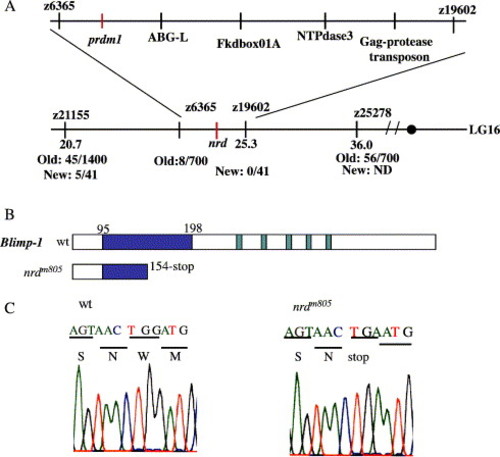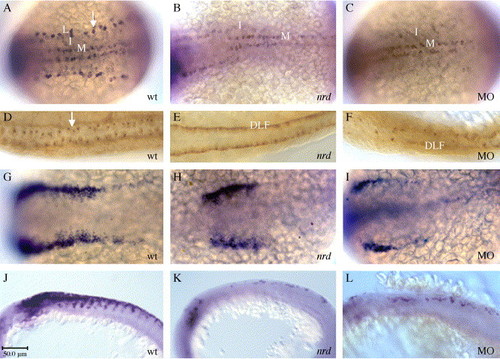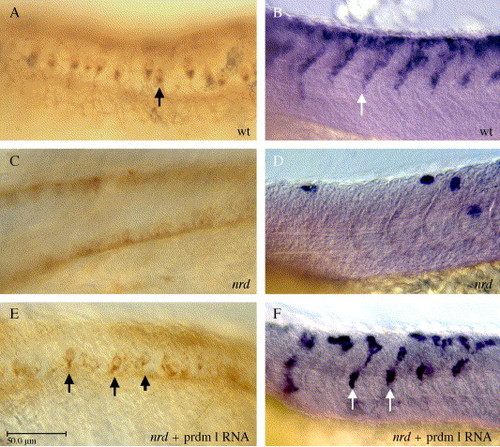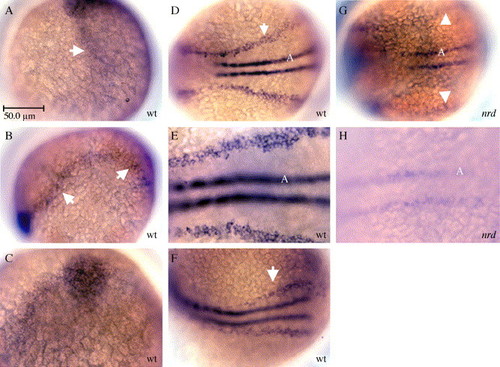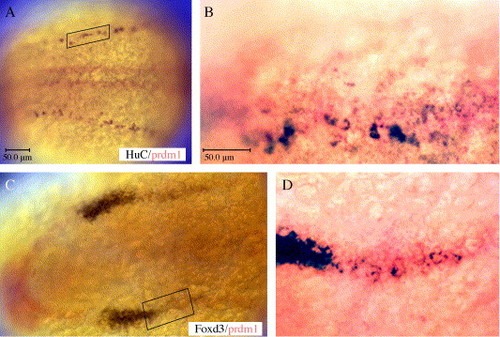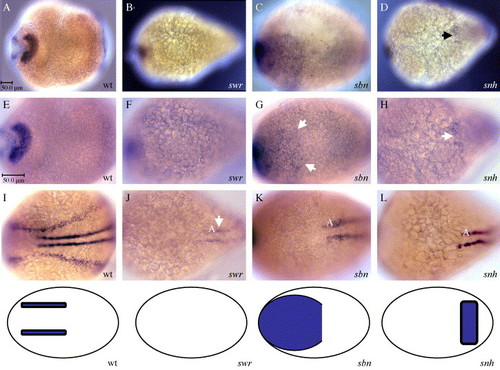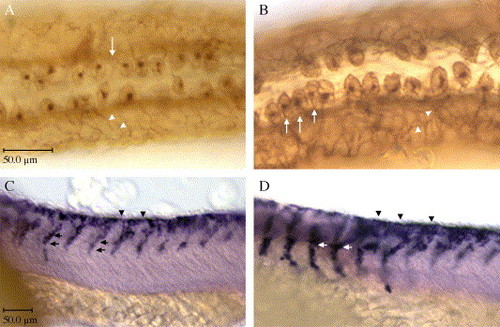- Title
-
Zebrafish narrowminded disrupts the transcription factor prdm1 and is required for neural crest and sensory neuron specification
- Authors
- Hernandez-Lagunas, L., Choi, I.F., Kaji, T., Simpson, P., Hershey, C., Zhou, Y., Zon, L., Mercola, M., and Artinger, K.B.
- Source
- Full text @ Dev. Biol.
|
Linkage between nrd and prdm1. (A) Physical and genetic maps of zebrafish linkage group (LG) 16. The genomic interval that contains nrd was determined using bulk segregant analysis with single strand length polymorphic (SSLP) markers (“z” positioned before the number). We positioned nrd between z6365 and z19602. Recombination frequency is listed as old and new. Old is from the original nrd strain nrdm805EK/WIK and New is nrdm805HuC:GFP. Several genes are located in this interval, including prdm1, which we identified as a candidate (Sanger Zv3 ensembl; other genes in the region include ABG-L, Fkdbox01A, NTPdase3, Gag-protease transposon). (B, C) Sequence comparison of wildtype (wt) and nrdm805 prdm1. (B) Diagrams illustrate conceptual wildtype and nrdm805 Blimp-1 (prdm1) protein products. The wildtype sequence contains a SET domain (blue) between amino acid 95–198 and 5 zinc finger DNA binding domains (green). The nrdm805 sequence has a stop codon (TGA) at amino acid 154 (exon 4) within the SET domain and before the zinc finger domains. (C) Sequence comparison between wildtype (wt; left) and nrdm805 (right). Sequence was confirmed in multiple PCR reactions within the two nrdm805 strains, and both contained the stop at position 154. |
|
prdm1 MO injection reduces neural crest and eliminates Rohon–Beard sensory neurons, reproducing the nrd phenotype. (A–C, G–I) 11 hpf dorsal views, anterior is to the left. (D–F) Twenty-four hpf dorsal views, anterior to the left. (J–L) Eighteen hpf lateral views, anterior is to the left. (A–C) In situ hybridization with HuC showing the three lateral stripes of primary neurons: lateral (L), intermediate (I) and medial (M). The neurons in the lateral stripe form RB sensory neurons (arrow in A) and are completely absent in nrd (B). Following prdm1 MO injection (C), there is a loss of RB sensory neurons, reproducing the nrd phenotype (B). (D–F) HNK-1 immunohistochemistry at 24 hpf, showing the characteristically large RB sensory neurons in a wildtype embryo (arrow in D). Both nrd (E) and prdm1 MO-injected embryos (F) lack RB sensory neurons. Consistent with a loss of RB sensory neurons, both nrd embryos (H) and prdm1 MO embryos (I) display a reduction in foxd3 expression at 11 hpf as compared to wildtype (G). This early reduction of neural crest remains in older embryos shown with crestin (J–L). Abbreviations: wt, wildtype; nrd, narrowminded mutant embryos; MO, prdm1 MO; DLF, dorsal lateral fasciculas; Scale bar is 50 μm. EXPRESSION / LABELING:
|
|
prdm1 mRNA injection can rescue Rohon–Beard sensory neurons and neural crest cells in nrd mutant embryos. HNK-1 immunohistochemistry, dorsolateral views; anterior is to the left. (A) Expression pattern of HNK-1 in RB sensory neurons in a wildtype embryo. (C) nrdm805 embryos lack RB sensory neurons and do not express HNK-1 in the dorsal neural tube. (E) RB sensory neurons are induced to form in nrdm805 mutant embryos after injection of prdm1 mRNA (arrows point to several RB sensory neurons). Crestin expression in lateral views, anterior to the left. (B) Wildtype expression of crestin at 24 hpf. (D) nrd embryos have very little trunk neural crest migration (F) After injection of prdm1 mRNA, numerous crestin-positive neural crest cells can be seen in the migration pathway (arrows). Abbreviations: wt, wildtype; nrd, narrowminded mutant embryos. Scale bar is 50 μm. EXPRESSION / LABELING:
|
|
Expression of prdm1 in the nervous system of wildtype and mutant nrd zebrafish embryos. Lateral views (A, B) and dorsal view(C–H) where anterior is to the left, except in A and C where anterior is to the top. (A) At 90% epiboly, expression is observed along the border of the neural plate where neural crest cells and RB sensory neurons are being specified (arrow), more strongly at the anterior-most border. At tailbud stages (B), expression remains high at the neural plate border (arrows). The expression is particularly strong at the anterior border at tail bud stages (C). (D) At 11 hpf, expression is high at the lateral edge of the neural plate (arrow; higher magnification in E), and also is expressed ventrally in the adaxial cells (A) adjacent to the midline. (F) By 13 hpf, the expression at the border of the neural plate remains only in the most posterior region (arrow). (G, H) Analysis of prdm1 expression in nrd mutant embryos at 11 hpf. Low (G) and high (H) magnification images of nrdm805 embryos showing reduced expression of prdm1, especially at the neural plate border (arrowheads in G). A slight reduction in expression is also observed in the ventral adaxial cells (A). Abbreviations: wt, wildtype; nrd, narrowminded mutant embryos; A, adaxial cells. Scale bar is 50 μm. EXPRESSION / LABELING:
|
|
prdm1 is expressed in the domain where neural crest and Rohon–Beard sensory neurons form. Double in situ hybridization of prdm1 with Foxd3 and HuC at 12 hpf; dorsal views, anterior to the left. (A, B) Low and high magnification views of prdm1 (red) and HuC (blue) expression. HuC-positive cells are co-expressed in the prdm1 expression domain. Boxes indicate region viewed under higher magnification in (B, D). (C, D) prdm1 (red) and Foxd3 (blue) expression indicate that neural crest cells are formed within the prdm1-expressing domain. Scale bar is 50 μm. EXPRESSION / LABELING:
|
|
Expression of prdm1 in the nervous system of BMP mutant zebrafish embryos. BMP mutants are visualized from the ventral side, where the reduction or expansion of the neural crest/RB sensory neuron domain is observed. Ventral (A–H) views of 12 hpf wildtype and BMP mutant embryos. swr (Bmp2b) mutant embryos (B, F) show an absence of prdm1 mRNA at the lateral border of the neural plate (compare to wildtype in A, E). The domain of expression of prdm1 is expanded in sbn (Smad5) embryos at 12 hpf (Low (C) and high (G) magnification; ventral views, compare to ventral view in wildtype in E), consistent with an increase of the neural crest/RB sensory neuron domain. Low (D) and high (H) magnification views of 12 hpf snh (Bmp7) showing a reduction in expression in the neural crest/RB sensory neuron domain of these embryos (arrows in D, H; compare to wildtype in A, E). Dorsal view of wildtype embryo in (I) as compared to dorsal views of swr (J), sbn (K), and snh (L) show that the adaxial expression (arrow in J) remains. Below, images are schematic representations of the neural crest domain in each of the mutant embryos as compared to wildtype. Since the BMP mutants are ventralized and the neural plate domain is expanded, the neural plate border form on the ventral side in sbn and snh and is completely absent in swr. Abbreviations: wt, wildtype; swr, swirl; sbn, somitabun; snh, snailhouse; A, adaxial cells. For (A–D), scale bar is shown in A and is 50 μm; for (E–L), scale bar is in E and is 50 μm. EXPRESSION / LABELING:
|
|
Ectopic expression of prdm1 increases neural crest and Rohon–Beard sensory neurons. (A, B) HNK-1 immunohistochemistry at 24 hpf; dorsal views, anterior to the left. (A) Wildtype expression of HNK-1, (B) Subsequent to prdm1 mRNA injections, RB sensory neurons are increased (arrows). (C, D) Crestin expression at 24 hpf, lateral views, anterior to the left. (C) Wildtype expression of crestin, (D) Following injection of prdm1 mRNA, the neural crest emigration and migration streams appear thick with cells (arrows) as compared with the same region in wildtype embryos. The migration of the cells also appears premature in the prdm1 expressing embryos. At the same time point in development, cells in prdm1-expressing embryos have migrated down to the yolk, whereas wildtype cells are only half way down their migration path. Scale bar for A, B is in A and is 50 μm; for C, D the scale bar is in C and is 50 μm. EXPRESSION / LABELING:
|
Reprinted from Developmental Biology, 278(2), Hernandez-Lagunas, L., Choi, I.F., Kaji, T., Simpson, P., Hershey, C., Zhou, Y., Zon, L., Mercola, M., and Artinger, K.B., Zebrafish narrowminded disrupts the transcription factor prdm1 and is required for neural crest and sensory neuron specification, 347-357, Copyright (2005) with permission from Elsevier. Full text @ Dev. Biol.

